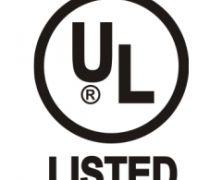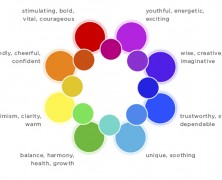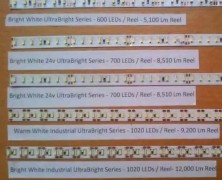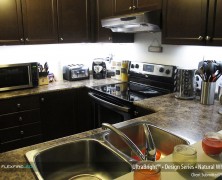While consumers are learning more about LED lighting, there are still many questions to be answered. Many LED products lack minimum safety, environmental and performance standards, leaving consumers unsure about product reliability. Thankfully, there are a number of recognized LED lighting certifications that consumers can rely upon. Let’s take a look at some of these certifications, and what they actually mean for consumers. UL Listed UL (Underwriters Laboratories) is an American safety and consulting company offering services in 104 countries worldwide. Established in 1894, UL first gained recognition by drafting safety standards and conducting safety analysis for electrical devices and components as the rise of residential electricity transmission made electronics ubiquitous in American households. As an LED lighting certification, UL Listed means that UL has tested representative samples of the product and determined it meets UL’s requirements based on its published Standards for Safety. The safety certification may also include additional information, meaning the product is UL Listed for Canada and the U.S. The UL logo used alone on packaging means the product and all its components have successfully passed UL examination as a working unit. LED lights that are UL Listed are safe for use in your home or business. Here is the UL Listed Website if you’d like to read more. CE Marking The CE mark is mandated for certain products sold within the European Economic Area, enabling freedom of movement in the European market. This marking means that the manufactured product meets EU safety, health and environmental standards that have been stipulated by legislation. Products demarcated with CE are not necessarily produced in Europe, but the marking means they can legally be sold there. All LED lights sold in Europe must carry the CE mark, which is often awarded by authorized third party organizations....
LEDs and the Psychology of Light and Color...
posted by Taran Volckhausen
“LIGHT reveals the glories of the external world and yet is the most glorious of them all. It gives beauty, reveals beauty and is itself most beautiful. It is the analyzer, the truth-teller and the exposer of shams, for it shows things as they are.” Edwin D. Babbitt, Principles of Light and Color While interior design plans give plenty of attention to wall paint and floor colors, lighting plays a critical role that is too often overlooked. Color and lighting influence our psychological functioning and well-being on a day-to-day basis, and understanding these influences is important when creating “human-centric” spaces. Designers have been using advanced color knowledge in this way for years, and the customizability of LED lighting now allows them to do the same with light. Let’s take a closer look at LEDs and the psychology of light and color. Humanity’s fascination with color has been with us since the dawn of civilization, with different colors used to symbolize and express various moods in ancient artwork spanning from Greece to Tibet. Color theory can be somewhat subjective, as certain colors elicit varying reactions in individuals based on personal preference and cultural backgrounds. It’s a truly interesting scientific field, and a great deal of thought has gone into exploring the psychological effects of color. One way of comparing colors in the visible spectrum is to divide them into “warm” and “cool” categories. The warm colors include red, orange, and yellow—think of the sun setting on the beach, or maple leaves strewn across the yard in early fall. These colors generally convey passion, positive energy, enthusiasm and happiness. In contrast, the cool colors include green, blue and purple—think of a solitary walk on a full moon night, or the depth of the ocean sea beneath a sleeping fisherman’s boat. Those colors convey...
Understanding The Different Numbers Used In LED Strip Lights...
posted by Flexfire LEDs
When shopping for LED strip lights, you’ll regularly come across numbered terms such as 3020, 3528, and 5050. So what do these numbers mean, and why are they important in your buying process? This simple explanation will help you in understanding the different numbers used in LED strip lights. First, a basic understanding of how the strips themselves are constructed. The LED chips are mounted onto a thin, flexible metal strip that acts as a heat sink, drawing heat from the light chips and allowing them to remain cool during operation. This construction accounts for the “SMD” you’ll often see in strip light specifications, which stands for Surface Mount Device. The four-digit designation refers to the dimensions of the chip itself, in millimeters. A 3528 chip, for example, measures 3.5mm by 2.8mm, while a 5050 chip is 5.0mm by 5.0mm square. These different sizes dictate how many chips can be placed on a strip, which in turn determines its particular light qualities. Each has its benefits, so let’s break them down one at a time. The 5050 chips that Flexfire LEDs uses are actually composed of 3 light diodes, a construction sometimes referred to as a tri-chip. With 3 diodes, a 5050 chip will be brighter than other chips with one individual diode. But while a tri-chip is theoretically three times brighter, their larger size means fewer of them will fit onto a strip’s PCB (Printed Circuit Board). It also means they will generate more heat, requiring a thicker PCB to act as a heat sink. Finally, a tri-chip can be constructed with different types of diodes in the same chip, generating unique visual results. The three diodes can be combined to create millions of different color combinations, making them an excellent choice for...
How To Install Under Cabinet LED Strip Lighting...
posted by Flexfire LEDs
Under cabinet lighting is one of the most common applications of LED strip lights. This relatively easy installation is a fantastic addition to any kitchen, office, or work bench area that would benefit from high quality direct task lighting. To illustrate this installation, we’ve put together this step-by-step tutorial on how to install under cabinet LED strip lighting. For this tutorial, we reached out to a customer named Owen in Toronto, Canada. Owen was seeking bright, usable light in his kitchen that could be hard-wired to a standard wall dimmer, and told us he had been, “scouring the web off and on for three years” in search of the perfect solution. In the end, he chose Flexfire LEDs UltraBright LED strip lights in natural white after viewing some of our online installation videos and feeling comfortable with our product quality. It’s important to note that for this installation, Owen enlisted the help of a licensed professional electrician. This is something we recommend for all installations, as it ensures code compliance and avoids potential injuries due to improper handling. Here is a “before” photo of his kitchen, using only the existing overhead lighting. And now, onto the installation! In order to achieve proper brightness and even light distribution, he used our solderless connectors to run two parallel sections of LED strip lights under each of three cabinet sections. In the end, he felt that one single strip would have been more than enough, and this parallel run wasn’t actually necessary. Also, note that the strip lights are very thin and low profile – the strips themselves are only actually visible when viewed from below as photographed here. As Owen says, “The low profile design means I don’t even have to rush to add a valence.”...
Flexfire LEDs Spring 2014 Photo Contest...
posted by Flexfire LEDs
We take pride in helping customers complete all sorts of LED lighting installations. From restaurants and hotels to basic kitchen redesigns, each project has a unique story. For this reason, we are always eager to see photographs of completed projects using Flexfire LEDs strip lights. To this end, we encourage you to participate in the Flexfire LEDs Spring 2014 Photo Contest. Every Entry Wins! We now have two separate contests, and everyone who submits a qualifying entry will win! Our standard photo contest awards prizes in each of three categories, while our new “Step-by-Step Tutorial” contest rewards those who share thorough details of their projects. Furthermore, everyone who sends us a qualifying submission for either contest will receive a coupon for $30 off any reel of Flexfire LEDs strip lights. Below you’ll find details for each of our two contests. Contest 1: Photo Contest Send us a high-resolution photograph of your completed project using Flexfire LEDs products and we’ll reward you with a coupon for $30 off any reel of Flexfire LEDs strip lights. One winner will be selected in each of these three categories: 1. Best Residential Installation (kitchens, bedrooms, bathrooms, basically anywhere in your home) 2. Best Commercial Installation (retail stores, bars/restaurants, offices, signage, etc.) 3. Best Hobby/Creative Installation (past examples include terrariums, Halloween costumes, and a flying wingsuit!) The winning project in each category will receive a FREE reel of Flexfire LEDs ColorBright strip lights. Again, please be sure to send us a high-resolution photograph, as blurred, low-quality images will not be considered. Contest 2: Step-by-Step Tutorial Contest Many of our customers see these great project photos and wonder, “How did they do that?” We’d love to share your step-by-step installation story on our blog. Everyone who submits a qualifying “Step-By-Step Tutorial” entry will receive a...










